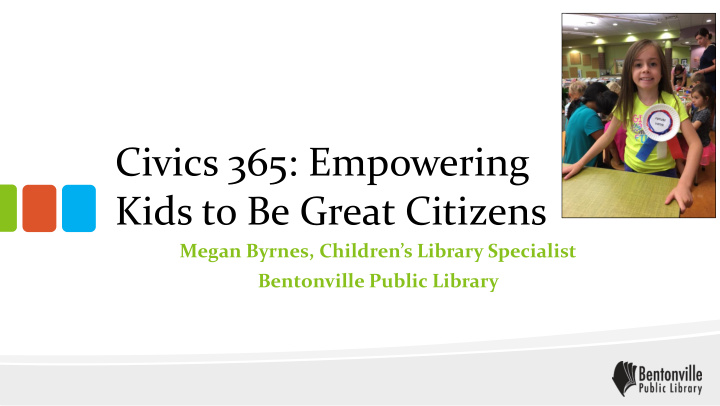



Civics 365: Empowering Kids to Be Great Citizens Megan Byrnes, Children’s Library Specialist Bentonville Public Library
Mike Wilkins, Preamble (1987), Smithsonian American Art Museum.
Welcome! • Introduction • Opening Activity: How do we start a discussion with kids about civics? • Why/So What? behind the project • What did we do and How did we do it? – Kids Rock the Vote (Fall 2016) – Kids Care Storytime (Summer 2017) – Hands On History/Curious Kids workshops (Summer 2017) – Constitution Day (Fall 2017) • Conclusion — Puzzle Activity and Lessons Learned
Why civics at the library, and why now? • Opportunity! Election 2016 • Need for civic literacy. – 70% of Americans didn’t know that the Constitution was the supreme law of the land (2011 Newsweek survey) – Only 26% of those surveyed could name all three branches of government (2016 Annenberg Public Policy Institute survey) – Only 24% of 12 th graders scored “proficient” on the 2010 National Assessment of Educational Progress civics test. • Libraries as educational and community centers
How It Began: Election 2016 • Civic engagement for children — Get them excited about voting and the upcoming election • Kids Rock the Vote! Programming: 6 weeks; Reached 1721 kids
Kids Care Storytime — Summer 2017 • How to make civics ideas more accessible for a younger audience? • 5 Key Themes: Bravery; Diversity; Peace and & Kindness; Democracy; Giving Back to Community
Hands On History/Curious Kids Workshops • Summer 2017; Grades 3-6 • More in-depth look at historic events & civics themes • Ex: The Little Rock Nine; Anne Frank
Constitution Day and Beyond Resources from The National Constitution Center: https://constitutioncenter.org/ Above: Nari Ward, We the People (black version) , 2015, Crystal Bridges Museum of American Art
Lessons Learned: Above: Mike Wilkins, Preamble (1987) , Smithsonian American Art Museum.
Activity: Make a Community Diversity Puzzle! • Using your Teaching Tolerance My Multicultural Self graphic organizer, brainstorm five things that are important to you. • Think of a visual way to represent these. • Use colored pencils to sketch your five things onto your puzzle piece. • Put the puzzle together and share!
Thank you! Any Comments/Questions? Contact me: mbyrnes@bentonvillear.com Phone: 479-271-6713 Visit BPL: www.bentonvillelibrary.org
Additional Resources: FreedomFlix: http://sdm-fflix.digital.scholastic.com/ National History Day: www.nhd.org Notable Books for a Global Society Annual Booklist: http://clrsig.org/nbgs.php Shaw, Matthew. “Civic Illiteracy in America,” Harvard Political Review , May 25, 2017. Accessed on September 22, 2017 at http://harvardpolitics.com/culture/civic-illiteracy-in-america Sites of Conscience coalition: http://www.sitesofconscience.org/ Teaching Tolerance, Southern Poverty Law Center: https://www.tolerance.org/ Ward, Nari. We the People (black version) . 2015, shoelaces. Crystal Bridges Museum of American Art. Wilkins, Mike. Preamble. 1987, paint, metal. Smithsonian American Art Museum. Youth Leadership Initiative, University of Virginia Center for Politics: http://www.youthleadership.net/
Recommend
More recommend